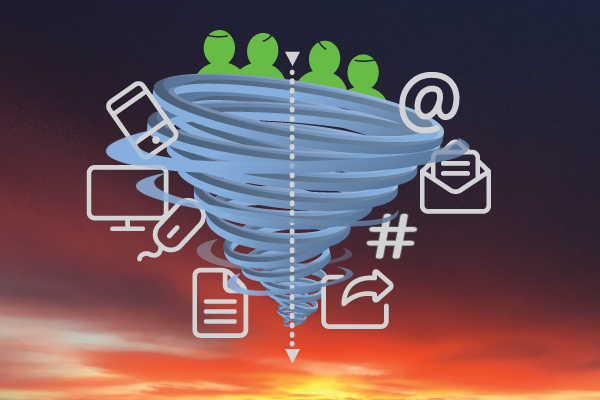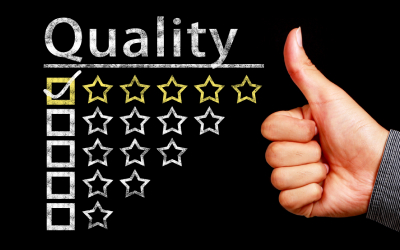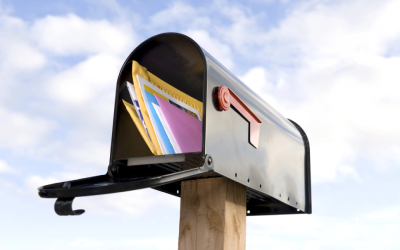Business to business direct marketers need to fortify themselves with data that connects with prospective buyers at every stage of the B2B buying cycle, in every way possible. This is true when targeting several decision makers at a particular company, or many prospects across an industry. Conventional wisdom often suggests that the stages of the buying cycle – awareness/discovery, research/consideration, and decision/purchase – are best served by particular channels, however that should not be taken as gospel.
The B2B buying cycle increasingly involves multiple “deciders”, resulting in a longer timeline. The process is anything but linear. The process resembles a swirling cloud as much as a funnel. (A funnel cloud?) Churning and looping often occurs among the key decision makers as issues are defined (then re-defined), discoveries are made, flags pop up, budgets are amended, specifications evolve, and new voices weigh in. Older persons may prefer physical pieces or phone consultations but are quite digitally literate. Millenials may favor more conversational SMS over business email or phone calls, but still open direct mail. Most if not all are likely to use email for correspondence and the web for reference, but in different ways. Each may only be a start point for their research and evaluation, and any or all can lead to a wide range of media presentations, from infographics to videos. In any case, every touchpoint must maintain whatever momentum has been gathered with a call to action.
As difficult as it seems for sales reps to break through and make a sale, those charged with buying are finding navigating the available solutions to their problems is just as hard. Making it easy for the various stakeholders to discover, share and compare what they have learned is key. For B2B sales reps the challenge is to make it as painless as possible for prospects to get to “Yes”.
One of the biggest hurdles to be overcome is the dearth of actual “face time” sales reps get from potential customers. The Gartner Group found that after spending time doing online and offline research, consulting internally, etc., it was found that only 17% of the time taken to consider a purchase was spent with vendor candidates. That speaks to getting prospects to the more “person to person” channels that include phone, chat, and SMS, getting sellers one step closer to live interaction.
Direct marketing channels have to work harder at providing information, establishing credibility, and offering incentives in order to build relationships and build business. This means reaching out via email, social media posts, and direct mail offering downloads and physical materials. The goal is to get the right message into the right hands at the right time. Hopefully interest is piqued leading to more personal communication in the form of a phone meeting or SMS chat. As familiarity grows, the opportunity for sales reps to personally pitch a business solution becomes more likely.
How then can marketing help the sales force to succeed? It still comes down to basics:
- The List
- The Offer
- The Call To Action
- The Design
- The Copy
Of all these, list data quality is credited with determining 50% of the outcome. If the communication doesn’t reach its audience, the conversation never starts. Data decay is high among businesses making strict data hygiene indispensable. The data must be current and accurate. Once obtained it needs to be segmented according to the different buyer personas to be targeted. Even then, decisions must be made as to what channel or channels will be used to target each recipient at whatever point on the buyer journey they currently occupy. If gaps in records exist they must be filled using business data appends. The responsibility falls to the seller to meet prospective buyers where they are, even if that requires meeting decision makers at simultaneously different stages of the buying cycle.
That said, here are those stages, along with the channels that are effective for achieving engagement, along with possible content types that nurture the prospect from lead to customer. Note that some of each appear multiple times based on the above.
Awareness/Discovery
The initial stage where prospects have identified a problem or need, and comb the landscape of potential suppliers whose products and services may provide solutions.
Channels: Display, Email, Direct Mail, Phone, Social Media
Content: Blog, Social Media Posts, eBooks, White Papers, eBooks, Videos, Webinars
Consideration/Research
The stage where a workable set of possible providers has been identified and vetted as credible based on their stated ability to specifically address the business’s needs. This deeper dive explores whether there is ample consensus for shortlisting candidates.
Channels: Display, Email, Direct Mail, Phone, Retargeting, Social Media, SMS
Content: Comparison Guides, Case Studies, Free Samples, Q&A Checklists
Decision/Purchase
The stage where the decision can actually be made to purchase the solution that is being offered by the standout candidate. Questions that were answered may need to be answered again. All problem/solution dots have to be connected to the satisfaction of those who may only take part at the end. Costs and timelines are mutually agreed upon. The new relationship takes shape and moves into the execution phase.
Channels: Personal URLs, SMS, Hyper-Personalized Email, Premium Printed Materials, Dedicated Live Chat
Content: Knowledge Bases, Loyalty Programs, “Live Fire Drill” Demos, Free Samples & Trials, Coupons
Retention/Relationship
This is where service and support take the lead. As good as a solution may be at the outset, questions, updates, changing requirements and glitches invariably arise. Ease of communication, accessible information, and speed of response fill in the rough spots to ensure that the relationship is a lasting one.
Channels: All of the above
Content: Automatic Upgrades/Updates, Loyalty Programs, Privileged Content Access, Dedicated Consultation, Webinars, Coupons
Most if not all of the channel data described above exists within the records of existing customers (a house list), or is available from data brokers. Keep in mind data best practices governing the use of data, such as email and SMS opt-in. Providing prospects who have shown interest with a means to easily select their preferred method of future contact is an important step in developing a responsive list.
Deal With A Full Deck
Identifying high quality leads and nurturing each one to fruition depends on being able to target all key decision makers throughout the buying cycle. The selling story must be able to reach prospects when and where they are receptive, with information, encouragement and solutions that meet their needs at that point in their process.
The choice is not so much which data to use, but how to use all available high quality data to make profitable, lasting connections. It is imperative that records be as complete as possible, and that direct marketers gain an understanding of when and how to deploy multi-channel messages. Some suggest contemplation (web sites, white papers, blogs). Others encourage rapid response (email, phone, chat, SMS). Ultimately they are connected at the moment of sale. In an effort to avoid getting lost in that funnel cloud, blanketing the buying cycle with responsive multi-channel data enables contact at all possible points.




